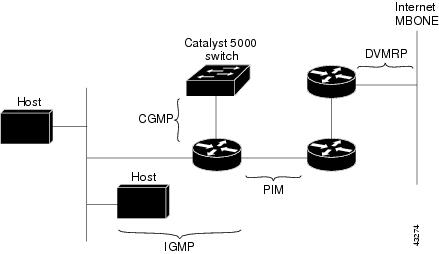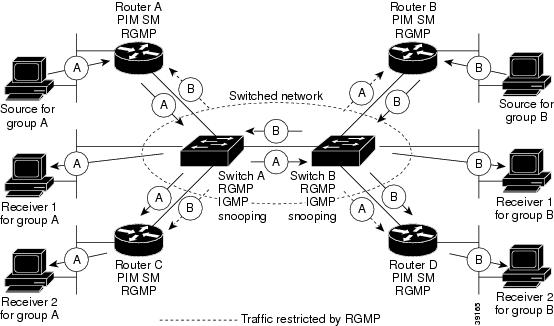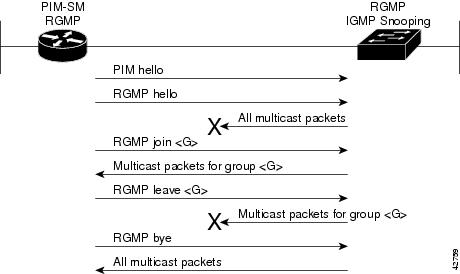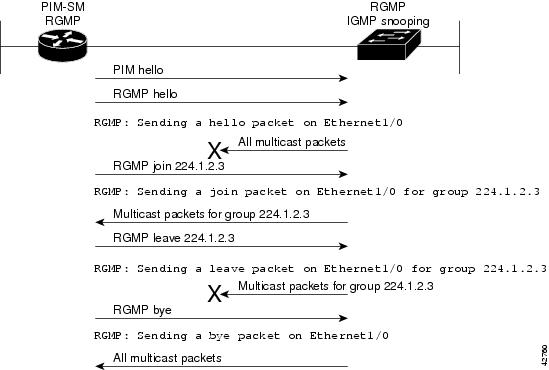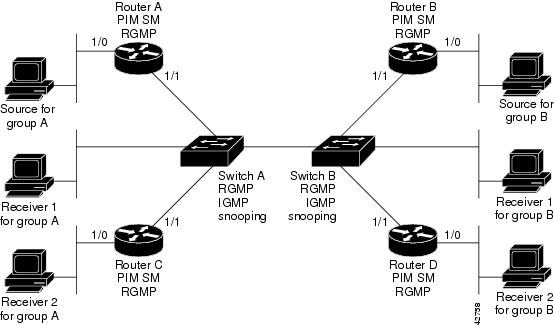 Feedback Feedback
|
Table Of Contents
Configuring Router-Port Group Management Protocol
Monitoring and Maintaining RGMP
Configuring Router-Port Group Management Protocol
Feature History
This chapter describes the Router-Port Group Management Protocol (RGMP). RGMP is a Cisco protocol that restricts IP multicast traffic in switched networks. RGMP is a Layer 2 protocol that enables a router to communicate to a switch (or a networking device that is functioning as a Layer 2 switch) the multicast group for which the router would like to receive or forward traffic. RGMP restricts multicast traffic at the ports of RGMP-enabled switches that lead to interfaces of RGMP-enabled routers.
For a complete description of the RGMP commands in this chapter, refer to theCisco IOS IP Multicast Command Reference. To locate documentation of other commands that appear in this chapter, use the command reference master index, or search online.
To identify the hardware platform or software image information associated with a feature, use the Feature Navigator on Cisco.com to search for information about the feature or refer to the software release notes for a specific release.
IP Multicast Routing Overview
The Cisco IOS software supports the following protocols to implement IP multicast routing:
•
Internet Group Management Protocol (IGMP) is used between hosts on a LAN and the routers on that LAN to track the multicast groups of which hosts are members.
•
Protocol Independent Multicast (PIM) is used between routers so that they can track which multicast packets to forward to each other and to their directly connected LANs.
•
Distance Vector Multicast Routing Protocol (DVMRP) is the protocol used on the MBONE (the multicast backbone of the Internet). The Cisco IOS software supports PIM-to-DVMRP interaction.
•
Cisco Group Management Protocol (CGMP) is a protocol used on routers connected to Catalyst switches to perform tasks similar to those performed by IGMP.
•
RGMP is a protocol used on routers connected to Catalyst switches or networking devices functioning as Layer 2 switches to restrict IP multicast traffic. Specifically, the protocol enables a router to communicate to a switch the IP multicast group for which the router would like to receive or forward traffic.
Figure 1 shows where these protocols operate within the IP multicast environment.
Figure 1 IP Multicast Routing Protocols
Note
CGMP and RGMP cannot interoperate on the same switched network. If RGMP is enabled on a switch or router interface, CGMP is automatically disabled on that switch or router interface; if CGMP is enabled on a switch or router interface, RGMP is automatically disabled on that switch or router interface.
RGMP Overview
RGMP enables a router to communicate to a switch the IP multicast group for which the router would like to receive or forward traffic. RGMP is designed for switched Ethernet backbone networks running PIM sparse mode (PIM-SM) or sparse-dense mode.
Note
RGMP-enabled switches and router interfaces in a switched network support directly connected, multicast-enabled hosts that receive multicast traffic. RGMP-enabled switches and router interfaces in a switched network do not support directly connected, multicast-enabled hosts that source multicast traffic. A multicast-enabled host can be a PC, a workstation, or a multicast application running in a router.
Figure 2 shows a switched Ethernet backbone network running PIM in sparse mode, RGMP, and IGMP snooping.
Figure 2 RGMP in a Switched Network
In Figure 2, the sources for the two different multicast groups (the source for group A and the source for group B) send traffic into the same switched network. Without RGMP, traffic from source A is unnecessarily flooded from switch A to switch B, then to router B and router D. Also, traffic from source B is unnecessarily flooded from switch B to switch A, then to router A and router C. With RGMP enabled on all routers and switches in this network, traffic from source A would not flood router B and router D. Also, traffic from source B would not flood router A and router C. Traffic from both sources would still flood the link between switch A and switch B. Flooding over this link would still occur because RGMP does not restrict traffic on links toward other RGMP-enabled switches with routers behind them.
By restricting unwanted multicast traffic in a switched network, RGMP increases the available bandwidth for all other multicast traffic in the network and saves the processing resources of the routers.
Figure 3 shows the RGMP messages sent between an RGMP-enabled router and an RGMP-enabled switch.
Figure 3 RGMP Messages
The router sends simultaneous PIM hello (or a PIM query message if PIM Version 1 is configured) and RGMP hello messages to the switch. The PIM hello message is used to locate neighboring PIM routers. The RGMP hello message instructs the switch to restrict all multicast traffic on the interface from which the switch received the RGMP hello message.
Note
RGMP messages are sent to the multicast address 224.0.0.25, which is the local-link multicast address reserved by the Internet Assigned Numbers Authority (IANA) for sending IP multicast traffic from routers to switches.
If RGMP is not enabled on both the router and the switch, the switch automatically forwards all multicast traffic out the interface from which the switch received the PIM hello message.The router sends the switch an RGMP join <G> message (where G is the multicast group address) when the router wants to receive traffic for a specific multicast group. The RGMP join message instructs the switch to forward multicast traffic for group <G> out the interface from which the switch received the RGMP hello message.
Note
The router sends the switch an RGMP join <G> message for a multicast group even if the router is only forwarding traffic for the multicast group into a switched network. By joining a specific multicast group, the router can determine if another router is also forwarding traffic for the multicast group into the same switched network. If two routers are forwarding traffic for a specific multicast group into the same switched network, the two routers use the PIM assert mechanism to determine which router should continue forwarding the multicast traffic into the network.
The router sends the switch an RGMP leave <G> message when the router wants to stop receiving traffic for a specific multicast group. The RGMP leave message instructs the switch to stop forwarding the multicast traffic on the port from which the switch received the PIM and RGMP hello messages.
Note
An RGMP-enabled router cannot send an RGMP leave <G> message until the router does not receive or forward traffic from any source for a specific multicast group (if multiple sources exist for a specific multicast group).
The router sends the switch an RGMP bye message when RGMP is disabled on the router. The RGMP bye message instructs the switch to forward the router all IP multicast traffic on the port from which the switch received the PIM and RGMP hello messages, as long as the switch continues to receive PIM hello messages on the port.
RGMP Configuration Task List
To configure RGMP, perform the tasks described in the following sections. The tasks in the first two section are required; the tasks in the remaining section are optional.
•
Enabling RGMP (Required)
•
Verifying RGMP Configuration (Optional)
See the end of this chapter for the section "RGMP Configuration Example."
Prerequisites
Before you enable RGMP, ensure that the following features are enabled on your router:
•
IP routing
•
IP multicast
•
PIM in sparse mode, sparse-dense mode, source specific mode, or bidirectional mode
If your router is in a bidirectional group, make sure to enable RGMP only on interfaces that do not function as a designated forwarder (DF). If you enable RGMP on an interface that functions as a DF, the interface will not forward multicast packets up the bidirectional shared tree to the rendezvous point (RP).
You must have the following features enabled on your switch:
•
IP multicast
•
IGMP snooping
Note
Refer to the Catalyst switch software documentation for RGMP switch configuration tasks and command information.
Enabling RGMP
To enable RGMP, use the following commands on all routers in your network beginning in global configuration mode:
See the "RGMP Configuration Example" section later in this chapter for an example of how to configure RGMP.
Verifying RGMP Configuration
To verify that RGMP is enabled on the correct interfaces, use the show ip igmp interface EXEC command:
Router> show ip igmp interfaceEthernet1/0 is up, line protocol is upInternet address is 10.0.0.0/24IGMP is enabled on interfaceCurrent IGMP version is 2RGMP is enabled
IGMP query interval is 60 secondsIGMP querier timeout is 120 secondsIGMP max query response time is 10 secondsLast member query response interval is 1000 msInbound IGMP access group is not setIGMP activity: 1 joins, 0 leavesMulticast routing is enabled on interfaceMulticast TTL threshold is 0Multicast designated router (DR) is 10.0.0.0 (this system)IGMP querying router is 10.0.0.0 (this system)Multicast groups joined (number of users):224.0.1.40(1)
Note
If RGMP is not enabled on an interface, no RGMP information is displayed in the show ip igmp interface command output for that interface.
Monitoring and Maintaining RGMP
To enable RGMP debugging, use the following command in privileged EXEC mode:
Figure 4 shows the debug messages that are logged by an RGMP-enabled router as the router sends RGMP join <G> and RGMP leave <G> messages to an RGMP-enabled switch.
Figure 4 RGMP Debug Messages
RGMP Configuration Example
This section provides an RGMP configuration example that shows the individual configurations for the routers and switches shown in Figure 5.
Figure 5 RGMP Configuration Example
Router A Configuration
ip routingip multicast-routinginterface ethernet 1/0ip address 10.0.0.1 255.0.0.0ip pim sparse-dense-modeno shutdowninterface ethernet 1/1ip address 10.1.0.1 255.0.0.0ip pim sparse-dense-modeip rgmpno shutdownRouter B Configuration
ip routingip multicast-routinginterface ethernet 1/0ip address 10.2.0.1 255.0.0.0ip pim sparse-dense-modeno shutdowninterface ethernet 1/1ip address 10.3.0.1 255.0.0.0ip pim sparse-dense-modeip rgmpno shutdownRouter C Configuration
ip routingip multicast-routinginterface ethernet 1/0ip address 10.4.0.1 255.0.0.0ip pim sparse-dense-modeno shutdowninterface ethernet 1/1ip address 10.5.0.1 255.0.0.0ip pim sparse-dense-modeip rgmpno shutdownRouter D Configuration
ip routingip multicast-routinginterface ethernet 1/0ip address 10.6.0.1 255.0.0.0ip pim sparse-dense-modeno shutdowninterface ethernet 1/1ip address 10.7.0.1 255.0.0.0ip pim sparse-dense-modeip rgmpno shutdownSwitch A Configuration
Switch> (enable) set igmp enableSwitch> (enable) set rgmp enableSwitch B Configuration
Switch> (enable) set igmp enableSwitch> (enable) set rgmp enable
Any Internet Protocol (IP) addresses used in this document are not intended to be actual addresses. Any examples, command display output, and figures included in the document are shown for illustrative purposes only. Any use of actual IP addresses in illustrative content is unintentional and coincidental.
© 2007 Cisco Systems, Inc. All rights reserved.
